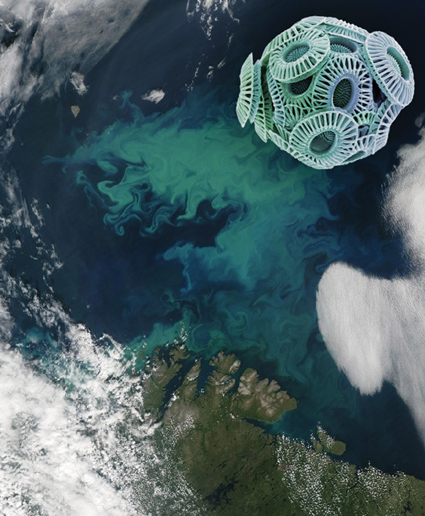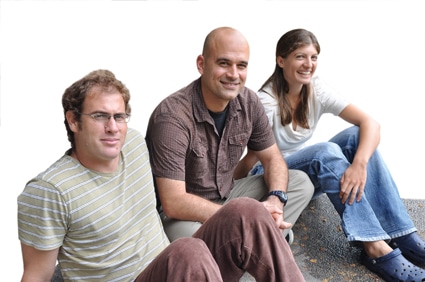Phytoplankton - tiny plant-like creatures floating in seawater - are essential to the health of the planet. What happens when they multiply uncontrollably and then collapse?

Phytoplankton - tiny plant-like creatures floating in seawater - are essential to the health of the planet. "Although they make up only half a percent of the global plant biomass, they are responsible for about half of the photosynthesis that takes place on our planet. Therefore, in fact, we have to thank phytoplankton for every second breath we take", says Dr. Assaf Vardi, who recently joined the Department of Plant Sciences at the Weizmann Institute of Science. These single-celled algae - whose oil is derived from the Greek word "migration" - form the basis of the marine food web: without the phytoplankton there would be no life in the oceans. For reasons that are not completely understood, their multiplication is accelerated from time to time, resulting in blooms of algae that cover hundreds and thousands of kilometers across seas, lakes and oceans, until a timed collapse occurs that causes them to disappear. During these blooms - which can even be identified in satellite images from space - the phytoplankton compare to the rainforests in their photosynthetic activity, meaning their ability to absorb carbon dioxide and release oxygen. In about 5% of algae species, the bloom is accompanied by less positive effects: in these cases, called "red tide", toxins are formed that are capable of harming fish and marine mammals, and when they are transported through the food web and drinking water - they also poison farm animals and A person.
A central question that preoccupies many scientists in different parts of the world is how climate change - the increase in temperature and carbon dioxide concentrations in the atmosphere - affects the fate of blooms in the oceans. The climate changes may increase the temperature of the sea water, thereby reducing the mixing between the layers of water - mixing which helps in supplying essential nutrients to the algae. In addition, sewage water high in nitrates, phosphates and other pollutants already today increases the bloom of harmful algae in lakes (for example in the Sea of Galilee) and near the beaches. Dr. Verdi's research - which takes him from the laboratory table to the open sea - attempts to study the cellular biology, genomics and complex ecology of the phytoplankton. He does this through genetic research, which is designed to reveal cellular processes through which these creatures deal with an environment that changes from time to time, and focuses on the processes responsible for algae blooms and their collapse. The creatures that star in his research include the "diatoms" - creatures with a shell made of a glass-like material (silica), with an endless variety of complex shapes - and the "coccolithophores", whose shell, which is made of calcium carbonate, making them vital participants in the carbon cycle.

In his post-doctoral research, Dr. Vardi and his research partners discovered that viruses are responsible for the collapse of algae blooms. When they closely examined the genetic sequences of phytoplankton and viruses, they discovered a number of surprising findings, which led them to develop new theories regarding the ecology and evolution of these organisms. Thus, for example, they discovered evidence of the existence of a cellular mechanism leading to the programmed death of cells (apoptosis). Apoptosis occurs in all types of multicellular organisms: damaged or old cells kill themselves, so that the entire organism can continue to live. Why would a single-celled organism - such as the phytoplankton - commit suicide, and what is the ecological significance of such suicide? One possible answer is that the genes for cell suicide evolved together in the host organism and the virus, with the aim of preventing infection and spread of the virus, which would cause the mass death of the host - and as a result, the death of the virus as well. Another possibility is that the viruses mobilize the apoptosis mechanisms of the host cell to "hatch" from it, after they finish their reproduction process inside it. This explanation is supported by the discovery that the algal viruses contain genes and biochemical pathways previously seen only in host organisms. Indeed, their genome is among the largest ever discovered in viruses, and includes 500 genes (compared to, for example, nine genes contained in the HIV virus).
There is another possibility: evolutionary processes may have led the phytoplankton to develop resistance mechanisms against virus infection, at the population level. That is, instead of a case of a cell sacrificing itself for the sake of the whole creature, the single-celled creature sacrifices itself for the sake of the "community" as a whole. In the past, scientists have already discovered that several types of microorganisms participate in complex group activity, while they communicate with each other through chemical signals. Dr. Vardi is now looking for evidence of the existence of such signals in phytoplankton, and is isolating the substances responsible for communication and determining cell fate - which he calls "infochemicals". Some of the substances he identified - some produced by phytoplankton and some by viruses - appear only at certain stages of the infection process. "We use these substances as biological markers (biomarkers), for the purpose of understanding more about biological interactions in the oceans," he says.
"The markers make it possible to monitor the state of the phytoplankton populations in the oceans, to identify the infection process in real time, and its effect on the food web." Thus, for example, in the research he recently carried out in the fjords on the coast of Norway, Dr. Verdi was able to cause such a bloom to appear under controlled conditions, and used special facilities and means to study the relationship between the virus and the host during the algae bloom. Other types of info-chemicals may be used by phytoplankton to defend themselves against competing marine microorganisms – similar to how antibiotics work. Dr. Verdi believes that even the "red tide" toxins may be a type of info-chemical: "It is possible that the phytoplankton use these substances as a means of communication and as a marker of environmental stress, with the aim of adapting to changing conditions." Identifying info-chemicals will enable biological control of the toxic blooms by disrupting the communication pathways between the algae using natural substances they produce.
An accurate understanding of the components of biological balance is an essential step in our attempts to restore balance, but such research can also have less predictable consequences. For example, the infochemicals that cause apoptosis may be used in future anti-cancer treatments, or as new antiviral drugs. In addition, deciphering the genetic sequences of phytoplankton with architecturally complex shells - such as those researched by Dr. Verdi - may provide useful information to scientists in other fields, such as nanotechnology researchers who are interested in imitating the design of such structures, or researchers engaged in the development of biofuels which are based on algae, looking for genes that will increase the amount of oils produced by algae.
personal
Assaf Verdi was born in Haifa and studied at the Hebrew University in Jerusalem. After receiving a PhD in molecular ecology in 2004, he embarked on post-doctoral research at the Ecole Normale Superieure in Paris, and at Rutgers University in New Jersey. In 2010 he joined the Weizmann Institute of Science.
Dr. Verdi is married to the artist Nibi Elroy, who is inspired by biological concepts from his scientific research - such as apoptosis and intercellular communication - and gives them a new interpretation in her works. Recently, the two collaborated in writing a children's book that explains ecological principles and processes through the presentation of micro-organism life in a drop of sea water.

2 תגובות
I didn't understand the connection between the virus and phytoplankton - does the virus cause the death of the plant?
rise and succeed
Best regards,
Ami Bachar